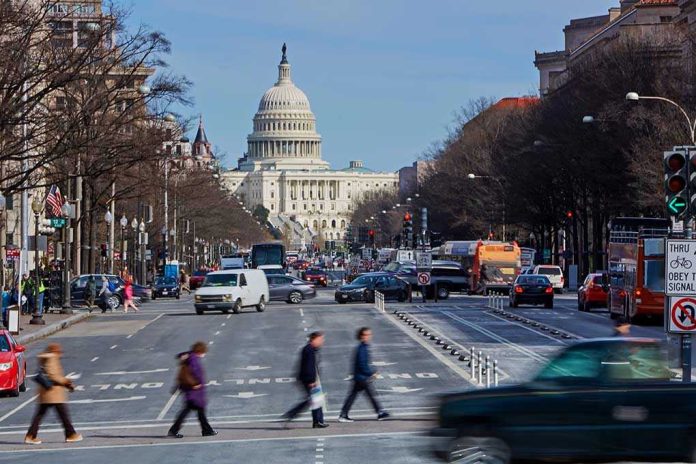Senator Josh Hawley’s relentless push to force Democrats into real spending reform has ignited a fierce standoff in Congress, putting the brakes on unchecked government growth that’s frustrated Americans for years.
Story Highlights
- Hawley champions aggressive shutdown funding bills to demand fiscal discipline from Democrats.
- S.499, the Government Shutdown Prevention Act of 2025, would cut funding automatically until Congress passes a budget.
- Stalled budget talks raise the risk of a government shutdown, spotlighting deep divisions over spending priorities.
- Conservatives see Hawley’s strategy as a necessary stand against runaway deficits and leftist spending agendas.
Hawley’s Confrontational Approach Puts Democrats Under Pressure
Senator Josh Hawley (R-MO) has taken center stage in the latest fiscal showdown, publicly vowing to “hold Democrats’ feet to the fire” over reckless government spending. By leveraging new government funding bills, Hawley seeks to force accountability and transparency, directly challenging the Democratic majority’s approach to appropriations. His strategy is more confrontational than many of his GOP colleagues, reflecting widespread conservative frustration with years of unchecked spending, progressive social priorities, and government overreach that have left taxpayers footing an ever-growing bill.
At the heart of Hawley’s campaign is his support for S.499, the Government Shutdown Prevention Act of 2025. Introduced by Senator Rand Paul (R-KY) with Hawley’s backing, this legislation proposes a dramatic shift in how Washington handles budget impasses. If Congress fails to pass appropriations, the act would automatically continue government funding at only 94% of the previous year’s level, with further reductions imposed every 90 days. This mechanism is designed to end the cycle of last-minute “blank checks” and force both parties to prioritize meaningful negotiations—something conservatives argue is long overdue given the nation’s spiraling debt and repeated deficit spending.
Stalled Budget Negotiations and the Threat of Shutdown
Despite mounting urgency, budget negotiations in early 2025 have stalled, with the Democratic Senate majority and a narrowly divided House unable to reach consensus. As the October 2025 deadline approaches, the risk of a government shutdown grows, directly impacting federal agencies, employees, and countless Americans who depend on government services. Hawley’s vocal stance has intensified partisan rhetoric, but it has also drawn clear lines: Republicans seek to rein in spending, while Democrats defend funding for expansive social and infrastructure programs. For conservatives, the looming shutdown is less a crisis and more a necessary wake-up call to impose fiscal responsibility that Washington has long evaded.
Hawley’s rhetoric and tactics have drawn sharp criticism from Democratic leaders, who label the threat of a shutdown as irresponsible and damaging to government operations. Yet, among conservative voters, these hardline tactics resonate deeply. After years of watching “woke” agendas, runaway entitlement programs, and unchecked federal power, many see this as a vital test of Congress’s willingness to stand up for the Constitution, family values, and the principle of limited government. The standoff has become a flashpoint in the broader culture war over the direction of national policy—one where Hawley’s willingness to use every tool available is seen not as obstruction, but as necessary defense against further erosion of core American values.
Short- and Long-Term Impacts of Fiscal Brinkmanship
In the short term, the threat of a shutdown carries real risks: potential furloughs for federal workers, delays in Social Security and veterans’ benefits, and disruptions to public services. Businesses that contract with the government could face cash flow problems, and markets may react with volatility. Yet, for many conservatives, these pains are the price of forcing accountability after years of overspending and government expansion. Long term, Hawley’s approach risks normalizing shutdown threats as a political tactic, potentially eroding public trust but also signaling to future Congresses that business as usual will no longer be tolerated. With midterm elections looming, both parties face pressure to show voters they are serious about the nation’s fiscal health and constitutional order.
Expert analyses offer mixed views: some warn that repeated shutdown brinkmanship could undermine government efficiency and morale, while others see automatic continuing resolutions like S.499 as essential to enforce real spending discipline. Historical precedent shows that previous shutdowns—whether over border security or health care—have been costly, but they have also forced the nation to confront fundamental policy disagreements. For conservatives, Hawley’s fight is about more than dollars and cents; it’s about restoring the balance of power, defending American values, and ensuring that Washington finally answers to the people rather than special interests or ideological extremes.
As this fiscal drama unfolds, Americans frustrated by years of leftist overreach and fiscal mismanagement are watching closely. Whether Hawley’s strategy succeeds or not, the message is clear: the era of unchecked spending and unaccountable government faces a historic challenge, and conservative leaders are prepared to draw a hard line in defense of the nation’s future.
Sources:
Congress.gov summary of S.499, Government Shutdown Prevention Act of 2025
Congress.gov summary of S.3012















